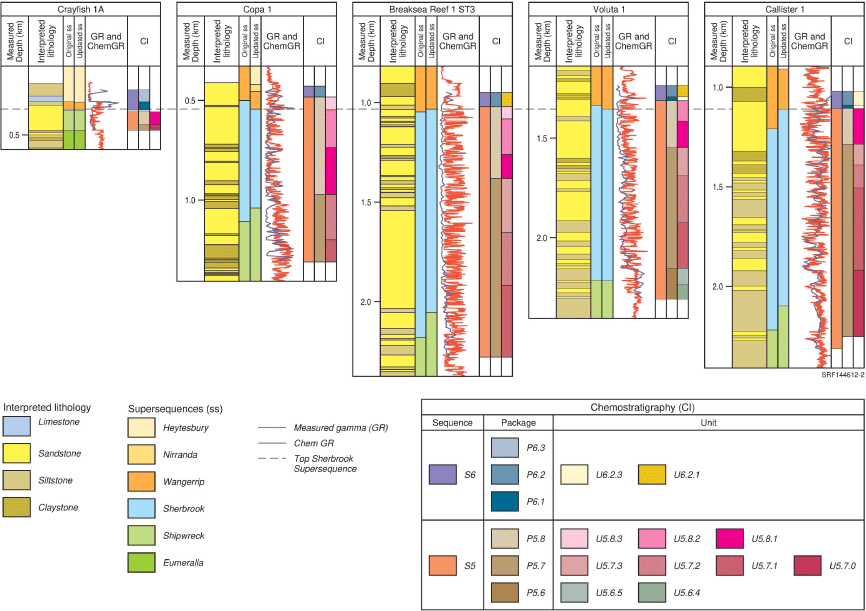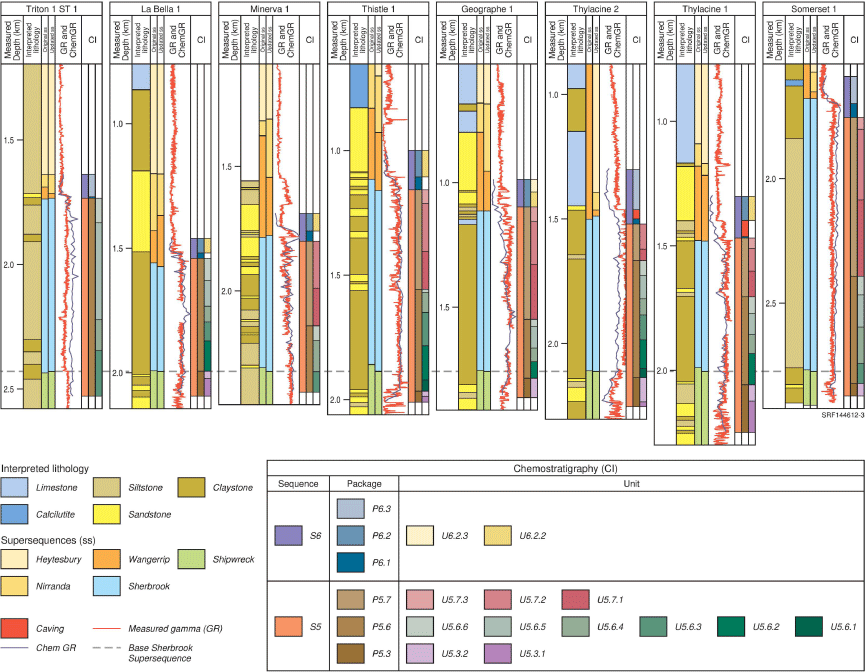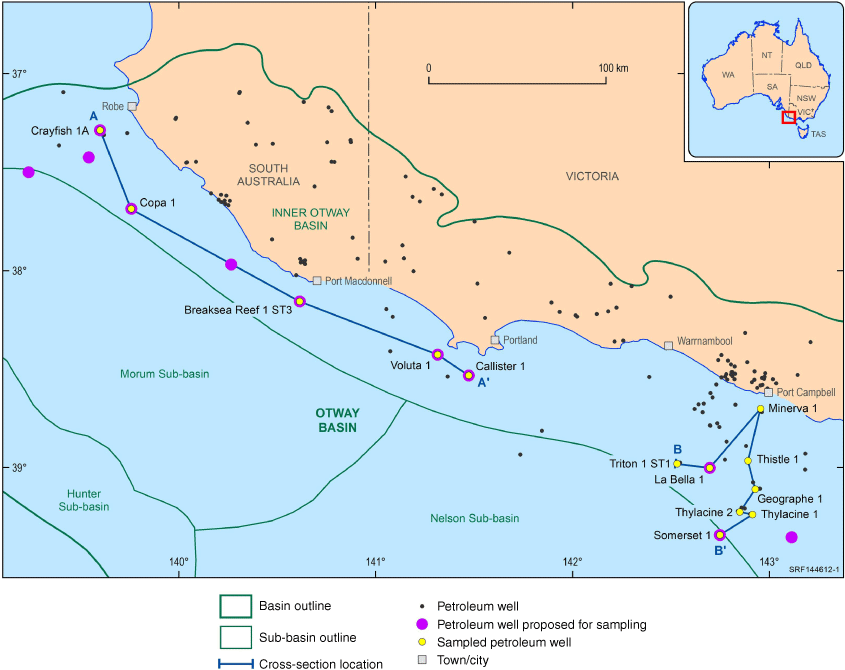Chemostratigraphy of the Sherbrook Supersequence – 13 wells from the offshore Otway Basin
Merrie-Ellen Gunning A * , Duy Nguyen A , David Riley B , Clare Tansell B and Giada Bufarale BA
B

Merrie-Ellen Gunning has an MBA from Melbourne Business School and a Bachelor of Applied Science in Geology from RMIT. M has over three decades of industry experience. Her experience has included postings in and overseeing operations across the world. Since joining Geoscience Australia in 2015 she has worked on prospectivity and CCS projects, and is currently Director – Offshore Energy Systems. |

Duy Nguyen holds a BEng and an MEng (Petroleum Engineering) from the University of New South Wales. He has researched CO2 geological sequestration in Australia. Duy has 5 years of industry experience. Since 2009, Duy has worked as a petroleum engineer at Geoscience Australia, assessing the CCS potential and petroleum prospectivity of Australian basins. Duy is currently contributing to a regional geological study of the Otway Basin. |

David Riley completed an MGeol and PhD from the University of Leicester, UK, and joined Chemostrat Ltd as a chemostratigrapher in October 2012. Since joining Chemostrat Ltd he has worked on projects from eastern Canada, UK North Sea, Middle East, Southeast Asia, and Australia. In 2022 he became Chemostrat Ltd Stratigraphy Manager, providing technical oversight on all chemostratigraphic studies. A Fellow of the Geological Society of London. |

Clare Tansell obtained her BSc in Geology and MSc in Petroleum Reservoir Geoscience from the University of Liverpool, before joining Chemostrat in 2018. The majority of her work has focussed on developing chemostratigraphic frameworks in the Middle-East and North Africa, she has also worked on both desktop and wellsite studies in the North Sea, sub-Saharan Africa and Australia. Clare is currently a Geoscience Team Lead at CGG. She is a member of the Geoscience Energy Society of Great Britain and Executive Assistant for the charity Geology for Global Development. |

Giada Bufarale’s geoscience experience of over 15 years, covering academia and consulting. In 2008, she earned an MSc in Geology with distinction, from the University of Milano-Bicocca (Italy) then completing a PhD in Geology at Curtin University (Western Australia) in 2018. Recently, she joined the Timescales of Mineral Systems Group at Curtin University, and my research aims to understand the origin, post-rift structural and tectonic history of phosphate-bearing sediments in northern Angola. |
Abstract
An elemental chemostratigraphic study of the offshore Otway Basin has been undertaken as part of a collaboration between Chemostrat and Geoscience Australia, the main aim of which is to better constrain the sequence boundaries of, and within, the Sherbrook Supersequence. This study includes the elemental analysis of 1185 cuttings samples from the Sherbrook Supersequence (and overlying stratigraphy) in 13 offshore wells. Sampling of cuttings was particularly challenging as many of the targeted wells have a paucity of material available for destructive analysis. Inductively Coupled Plasma-Optical Emission Spectrometry and Mass Spectrometry (ICP-OES and MS) analysis was undertaken to establish a regional elemental chemostratigraphic framework of the Sherbrook Supersequence. The resultant framework comprises two chemostratigraphic sequences, seven chemostratigraphic packages and eighteen chemostratigraphic units. While the analysis could not clearly distinguish the base of the Sherbrook Supersequence it has provided valuable insight into correlations between wells, within the Sherbrook and overlying Wangerrip supersequences. Importantly it has confirmed that in the offshore part of the basin sedimentary processes and inputs remain unchanged from the Shipwreck to the Sherbrook (Turonian–Maastrichtian).
Keywords: chemostratigraphy, Inductively Coupled Plasma-Optical Emission Spectrometry, Mass Spectrometry, offshore, Otway Basin, Sherbrook Supersequence, Shipwreck Supersequence, Shipwreck trough, Well correlation.
Introduction
The base of the Late Cretaceous Sherbrook Supersequence is poorly constrained in regional interpretation of the offshore Otway Basin. Well log data, cuttings and core show little distinction between the Sherbrook and the underlying Shipwreck Supersequence (Nguyen et al. 2022, 2024). Correlation between wells is challenging due to distances between wells (Fig. 1) and structural complexity (Nicholson et al. 2024). A chemostratigraphic study of available cuttings, from across the offshore Otway Basin, was undertaken to determine whether the base of the Sherbrook Supersequence could be better constrained and therefore improve regional correlation.
Chemostratigraphy of the Offshore Otway Basin
Chemostratigraphic analysis
Elemental chemostratigraphy is the study of rock units whereby chemical compositions are used to distinguish between chemically differentiable zones and to correlate between these zones (Riley et al. 2024). Chemostrat Australia Pty Ltd was engaged by Geoscience Australia to undertake Inductively Coupled Plasma-Optical Emission Spectrometry and Mass Spectrometry (ICP-OES and MS) analysis (Jarvis and Jarvis 1992), to establish a regional elemental chemostratigraphic framework for the Sherbrook Supersequence, offshore Otway Basin. For each of the 1185 samples submitted for analysis, 50 elements were quantified. These data were then analysed and interpreted to identify chemically distinct chemostratigraphic sequences, packages and units that can be correlated between wells.
Sampling of cuttings
1185 cuttings samples from the Sherbrook Supersequence (and overlying stratigraphy) in 13 wells, located offshore Otway Basin, were sampled at the National Offshore Petroleum Data and Core Repository facility in Carlisle, Western Australia.
Initially wells to be sampled were chosen based on their ability to provide regional representation of the top and base of the Sherbrook Supersequence (Fig. 1 wells in purple) and a focus on the less well explored parts of the basin, however as the study progressed it was necessary to adapt due to many of the selected wells having limited cuttings sample available for destructive analysis. As a result, the geographic distribution of data (Fig. 1 wells in yellow) is driven by sample availability rather than geology.
Chemostratigraphic interpretation
A chemostratigraphic framework was developed, with nomenclature adapted from Forbes et al. (2020). The framework for this study (Riley et al. 2024) comprises two chemostratigraphic sequences, seven chemostratigraphic packages and eighteen chemostratigraphic units. A chemical gamma-ray curve (the ChemGR) has been calculated and compared to the measured gamma-ray (GR), to demonstrate the representativeness of the samples.
Results
In general, despite the challenges of access to cuttings and age of the wells, the quality of sampling was high as indicated by good correlation between the ChemGR curve (grey curve on well track in Figs 2 and 3) and the measured GR (red curve of well track in Figs 2 and 3).
Transect A – Well correlation (NW–SE) of the western offshore Otway Basin wells from the study. Tracks left to right (1) depth (m MD below well datum), (2) interpreted lithology (Nguyen et al. 2022), (3) original supersequence (Nguyen et al. 2022), (4) updated supersequences, (5) measured gamma-ray (GR, red) (Nguyen et al. 2022) and calculated gamma-ray (ChemGR, grey) (Riley et al. 2024), (6) chemostratigraphic interpretation (Sequence, Packages and Units) (Riley et al. 2024). Flattened on the updated top of the Sherbrook Supersequence.

Transect B – Well correlation of the offshore Otway Basin – Shipwreck Trough wells from the study. Tracks left to right (1) depth (m MD below well datum), (2) interpreted lithology (Nguyen et al. 2024), (3) original supersequences (Nguyen et al. 2024), (4) updated supersequences, (5) measured gamma-ray (GR, red) (Nguyen et al. 2024) and calculated gamma-ray (ChemGR, grey) (Riley et al. 2024), (6) chemostratigraphic interpretation (Sequence, Packages and Units) (Riley et al. 2024). Flattened on the updated base of the Sherbrook Supersequence.

Well marker and biostratigraphic information within the Sherbrook Supersequence was not provided in advance of the study; only initial top and base Sherbrook Supersequence markers, predominantly from seismic picks. The chemostratigraphic interpretation has since been integrated with biostratigraphy (C. Hanneford and D. Mantle unpubl. data 2020) and markers constrained using the framework in Charles et al. (2019). Therefore, in terms of sampling the target stratigraphic section within the wells, this was achieved, with the overlying Wangerrip Supersequence and deeper Shipwreck Supersequence partially characterised in the chemostratigraphic analysis in all sampled wells.
There were two key objectives of the study, to better constrain the Sherbrook–Shipwreck supersequence boundary in the wells, and to assess the application of chemostratigraphy in regional mapping.
Application of chemostratigraphy at a basin and sub-basin scale
Despite the sparse distribution of the wells (Fig. 1) and structural complexity between wells (Nicholson et al. 2024), the application of chemostratigraphy, and specifically the resultant chemostratigraphic interpretation from Riley et al. (2024), in a regional context is valuable. The analysis of the results is best examined using the two key transects shown in Fig. 1. Correlations between wells based on the chemostratigraphic interpretation are evident across Transect A (Fig. 2) in the western part of the offshore basin; and, across Transect B (Fig. 3) within the Shipwreck Trough. These transects were chosen based on geological setting and the correlation of the chemostratigraphic interpretation with supersequence boundaries.
Transect A (Fig. 2) from the western part of the offshore basin includes a number of wells from the study (Riley et al. 2024) which recommended the base Sherbrook Supersequence marker be reviewed in four wells; Crayfish-1A, Copa 1, Breaksea Reef-1-ST3, and Callister-1. Following the recommended review, the latter three wells resulted in changes to both the top and base of the Sherbrook Supersequence (Fig. 2), albeit predominantly due to reinterpretation with available biostratigraphy. While Crayfish-1A has such a compressed Sherbrook succession that no changes were warranted.
In the Shipwreck Trough wells (Fig. 3), the base of the Sherbrook Supersequence is commonly interpreted within chemostratigraphic unit 5.6.2. And, with the exception of La Bella-1, the shipwreck chemostratigraphic package 5.6 has good correlation with the lower Sherbrook Supersequence. In this part of the basin a more targeted chemostratigraphic interpretation of the units within Package 5.6 could benefit correlation, as could extending sampling and interpretation deeper into the Shipwreck Supersequence.
When considering the chemostratigraphic interpretation at a basin scale we can see that, unsurprisingly, due to the significant unconformity near the Paleogene–Cretaceous boundary, the chemostratigraphic analysis shows a basin wide and consistent change between chemostratigraphic sequences 5 and 6, commonly near the base of the Wangerrip Supersequence, except for Thylacine-2, Somerset-1 and Crayfish-1A, where it is in the upper Sherbrook.
Sherbrook–Shipwreck supersequence boundary
The objective to better constrain the supersequence boundary between the Shipwreck and Sherbrook supersequences, in the offshore Otway Basin, is not achieved through chemostratigraphy. Forbes et al. (2020) differentiated the Skull Creek (Sherbrook Supersequence) and Belfast (Shipwreck Supersequence) mudstones into S5-P6 and S5-P4 (or P5) respectively. The use of this previous work (Forbes et al. 2020) to develop the framework for Riley et al. (2024) enabled differences and gaps to be highlighted. With the offshore and onshore chemostratigraphic data and interpretation for the Sherbrook Supersequence, a regional integrated study to examine the Skull Creek and Belfast Mudstones, and their progression from the onshore to the offshore is a logical next step.
The consistency of the offshore depositional environment during the Cretaceous, in contrast to the onshore, is evident in those key ratios provided in the data that represent changes in sedimentary processes (Riley et al. 2024). With biostratigraphic certainty providing constraints in many of the wells, we can clearly see that from the deposition of the Shipwreck Supersequence through the Sherbrook Supersequence, in the offshore Otway, there are no indications of change in sorting, composition, sediment recycling, weathering or provenance.
Although chemostratigraphy does not clearly distinguish the K90 (Charles et al. 2019) boundary, opportunities to better correlate between wells in the offshore Otway Basin, within the Sherbrook Supersequence and upper Shipwreck Supersequence, come from the sequences, packages and units of the chemostratigraphic interpretation. This approach is particularly valuable in the offshore Otway context because it is independent of lithology, which has proven a challenge in differentiation of sequences in the Otway for many years.
Conclusion
Constraint of the boundary between the Shipwreck and Sherbrook supersequences, in the offshore Otway Basin, is not achieved using chemostratigraphy. However, application of chemostratigraphy at a basin and sub-basin scale has proved valuable, providing the opportunity to further examine the results to inform large scale, chemostratigraphically based, correlations between wells within the Sherbrook–Shipwreck.
Data availability
The data, a full report, and the chemostratigraphic interpretation results are available from Geoscience Australia (Riley et al. 2024) https://pid.geoscience.gov.au/dataset/ga/149127.
Acknowledgements
Luiqi Wang and Cameron Mitchell reviewed the draft manuscript. Chris Evenden prepared the figures. This abstract is published with the permission of the CEO, Geoscience Australia.
References
Jarvis I, Jarvis KE (1992) Inductively coupled plasma-atomic emission spectrometry in exploration geochemistry. Journal of Geochemical Exploration 44(1–3), 139-200.
| Crossref | Google Scholar |
Nguyen D, Edwards D, Gunning M, Bernardel G (2022) ‘The northwest offshore Otway Basin well folio.’ (Geoscience Australia: Canberra) doi:10.26186/146429
Nguyen D, Cubitt C, Edwards D, Abbott S, Bernardel G (2024) ‘The central and southeast offshore Otway well folio.’ (Geoscience Australia: Canberra) doi:10.26186/149358
Nicholson C, Abbott S, Bernardel G, Poudjom Djomani Y (2024) A new perspective on regional structural architecture across the offshore Otway Basin. Australian Energy Producers Journal 64, S416-S422.
| Crossref | Google Scholar |
Riley DA, Tansell C, Bufarale G, Pearce TJ, Nguyen D, Gunning M (2024) ‘Defining a chemostratigraphic framework for the Sherbrook Supersequence - inorganic geochemical analysis of 13 petroleum wells from the offshore Otway Basin.’ (Geoscience Australia: Canberra) doi:10.26186/149127
 Merrie-Ellen Gunning has an MBA from Melbourne Business School and a Bachelor of Applied Science in Geology from RMIT. M has over three decades of industry experience. Her experience has included postings in and overseeing operations across the world. Since joining Geoscience Australia in 2015 she has worked on prospectivity and CCS projects, and is currently Director – Offshore Energy Systems. |
 Duy Nguyen holds a BEng and an MEng (Petroleum Engineering) from the University of New South Wales. He has researched CO2 geological sequestration in Australia. Duy has 5 years of industry experience. Since 2009, Duy has worked as a petroleum engineer at Geoscience Australia, assessing the CCS potential and petroleum prospectivity of Australian basins. Duy is currently contributing to a regional geological study of the Otway Basin. |
 David Riley completed an MGeol and PhD from the University of Leicester, UK, and joined Chemostrat Ltd as a chemostratigrapher in October 2012. Since joining Chemostrat Ltd he has worked on projects from eastern Canada, UK North Sea, Middle East, Southeast Asia, and Australia. In 2022 he became Chemostrat Ltd Stratigraphy Manager, providing technical oversight on all chemostratigraphic studies. A Fellow of the Geological Society of London. |
 Clare Tansell obtained her BSc in Geology and MSc in Petroleum Reservoir Geoscience from the University of Liverpool, before joining Chemostrat in 2018. The majority of her work has focussed on developing chemostratigraphic frameworks in the Middle-East and North Africa, she has also worked on both desktop and wellsite studies in the North Sea, sub-Saharan Africa and Australia. Clare is currently a Geoscience Team Lead at CGG. She is a member of the Geoscience Energy Society of Great Britain and Executive Assistant for the charity Geology for Global Development. |
 Giada Bufarale’s geoscience experience of over 15 years, covering academia and consulting. In 2008, she earned an MSc in Geology with distinction, from the University of Milano-Bicocca (Italy) then completing a PhD in Geology at Curtin University (Western Australia) in 2018. Recently, she joined the Timescales of Mineral Systems Group at Curtin University, and my research aims to understand the origin, post-rift structural and tectonic history of phosphate-bearing sediments in northern Angola. |



